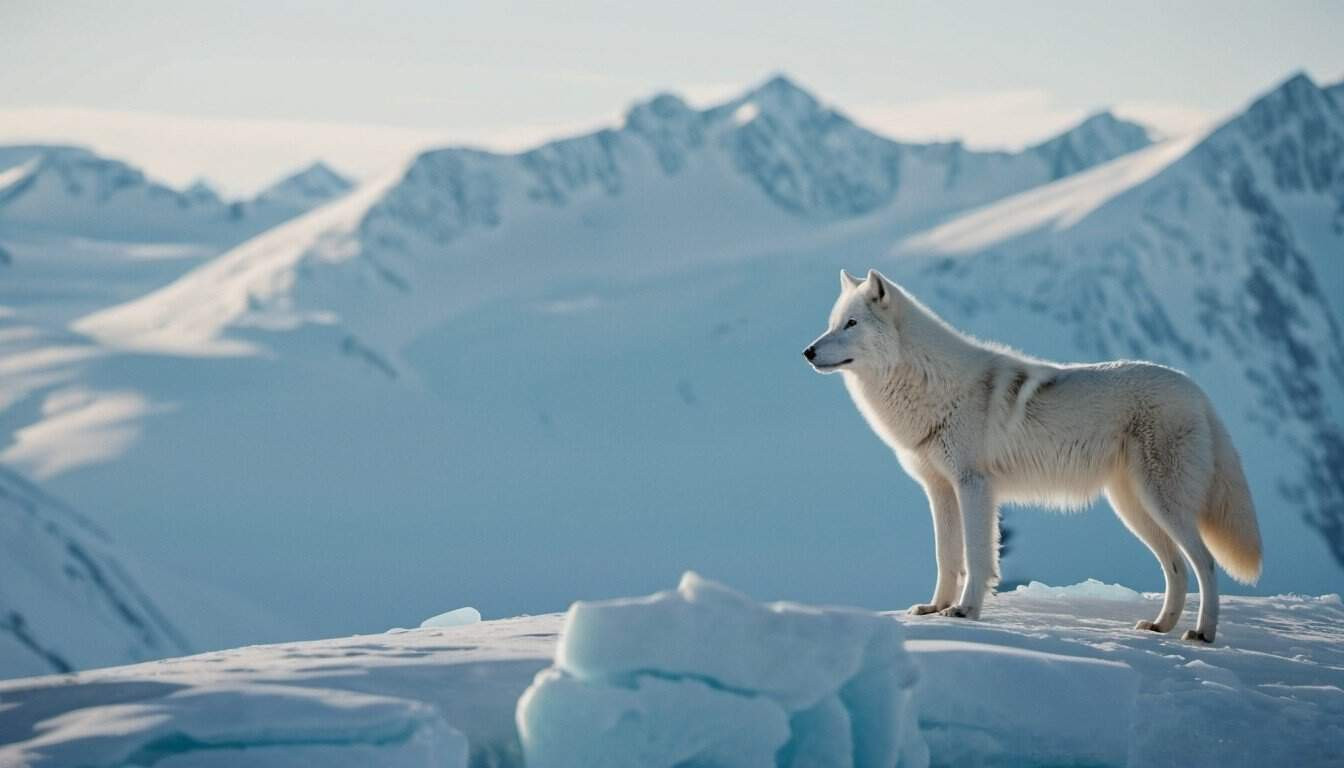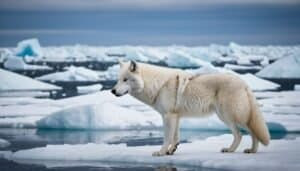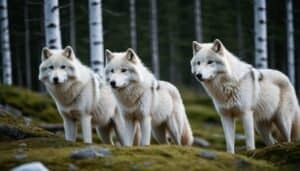Introduction
The Arctic wolf, a resilient and elusive predator, faces numerous challenges in its icy habitat. This article explores the main threats to Arctic wolf populations, evaluates the effectiveness of current conservation strategies, and highlights the roles of communities and organizations in safeguarding these majestic creatures
We will also look ahead to the future of Arctic wolf conservation, considering proposed strategies and necessary adaptations to ensure their survival in a changing climate
Main Threats to Arctic Wolf Populations
The Arctic wolf, known for its adaptability to harsh environments, faces several significant threats that jeopardize its survival. Understanding these threats is crucial for developing effective conservation strategies
Here, we explore the primary dangers to Arctic wolf populations, including habitat loss, climate change impacts, and human-wildlife conflict
Habitat Loss and Fragmentation
Habitat loss and fragmentation are among the most pressing threats to Arctic wolves. As human activities expand into the Arctic regions, the wolves’ natural habitats are increasingly disrupted
Infrastructure development, such as roads, pipelines, and mining operations, fragments the landscape, making it difficult for wolves to find food, shelter, and mates
The fragmentation of their habitat not only isolates wolf populations but also reduces their hunting grounds. With fewer resources available, wolves are forced to travel longer distances, which can lead to increased mortality rates, particularly during harsh winters
Conservation efforts must focus on protecting large, contiguous areas of habitat to ensure the long-term survival of the Arctic wolf
Climate Change Impacts
Climate change poses a severe threat to Arctic wolf populations by altering their environment in profound ways. Rising temperatures result in the melting of sea ice and permafrost, which in turn affects the entire Arctic ecosystem
Prey availability, such as caribou and musk oxen, is directly impacted by these changes, influencing wolf hunting patterns and success rates
Warmer temperatures also introduce new species to the Arctic, which can compete with or prey upon traditional Arctic species, disrupting the food web. Furthermore, changes in vegetation and snow cover can affect the wolves’ ability to camouflage and hunt effectively
Addressing climate change is critical to maintaining the balance of the Arctic ecosystem and ensuring the survival of the Arctic wolf
Human-Wildlife Conflict
As human activities encroach further into Arctic territories, the frequency of human-wildlife conflicts increases
These conflicts often arise when wolves prey on livestock or come into close contact with human settlements. In retaliation, wolves are sometimes hunted or killed, further reducing their populations
Efforts to mitigate human-wildlife conflict include educating local communities about the importance of wolves in the ecosystem, implementing non-lethal deterrents, and developing compensation schemes for livestock losses
By fostering coexistence between humans and wolves, conservationists can reduce the negative impact on Arctic wolf populations
Conservation Strategies and Their Effectiveness
Efforts to conserve the Arctic wolf have involved a variety of strategies aimed at protecting their habitat, reducing human-wildlife conflict, and ensuring their long-term survival
Evaluating the effectiveness of these strategies is crucial to adapting and improving conservation measures. Here, we discuss the roles of protected areas and reserves, anti-poaching measures, research and monitoring programs, success stories in conservation, and the ongoing challenges and limitations faced by these initiatives
Protected Areas and Reserves
One of the primary strategies for conserving the Arctic wolf is the establishment of protected areas and reserves. These designated regions aim to provide safe habitats where wolves can live, hunt, and breed without the immediate threat of human interference
National parks and wildlife reserves across the Arctic regions play a crucial role in maintaining stable wolf populations
Protected areas have been effective in preserving critical habitats and reducing direct human impact. By ensuring that large tracts of land remain undeveloped, these areas help mitigate habitat loss and fragmentation
However, the effectiveness of protected areas is sometimes limited by insufficient enforcement of regulations and the encroachment of illegal activities such as poaching and mining
Anti-Poaching Measures
Poaching remains a significant threat to the Arctic wolf, particularly in regions where their pelts and other body parts are highly valued
Anti-poaching measures are essential to reduce illegal hunting and protect wolf populations. These measures include increased patrolling of protected areas, the use of technology such as drones and camera traps, and stricter penalties for poachers
The implementation of anti-poaching measures has seen varying levels of success. In some areas, enhanced surveillance and community involvement have led to a noticeable decrease in poaching activities
However, in remote and vast Arctic regions, maintaining constant vigilance is challenging, and poaching still poses a threat to wolf populations
Research and Monitoring Programs
Research and monitoring programs are fundamental to understanding Arctic wolf behavior, population dynamics, and the effectiveness of conservation strategies
These programs involve tracking wolf movements, studying their diet and health, and monitoring environmental changes that impact their habitat. By gathering comprehensive data, conservationists can make informed decisions and adjust strategies as needed
Programs such as satellite collaring and genetic studies have provided valuable insights into wolf populations and their interactions with the ecosystem. Continuous monitoring is essential to detect early signs of population decline or habitat degradation, allowing for timely interventions
Despite their importance, these programs often face funding and logistical challenges, limiting their scope and reach
Success Stories in Conservation
There have been notable successes in Arctic wolf conservation, demonstrating the potential for positive outcomes when effective strategies are implemented
For instance, the establishment of large protected areas in regions like Canada and Greenland has helped stabilize wolf populations and protect their habitats. Community-led initiatives have also played a significant role in fostering coexistence between humans and wolves
Collaborative efforts between governments, non-governmental organizations, and local communities have resulted in increased awareness and support for wolf conservation. These success stories highlight the importance of a multi-stakeholder approach and the need for ongoing commitment to conservation efforts
Ongoing Challenges and Limitations
Despite the successes, numerous challenges and limitations persist in Arctic wolf conservation. The vast and remote nature of the Arctic makes it difficult to enforce conservation measures consistently
Climate change continues to alter the landscape in unpredictable ways, complicating efforts to protect wolf habitats. Additionally, securing sustained funding and political support for long-term conservation initiatives remains a significant hurdle
Human activities such as industrial development and resource extraction pose ongoing threats to Arctic wolf populations. Balancing economic interests with conservation goals is a complex issue that requires careful management and negotiation
Addressing these challenges is crucial to ensuring the effectiveness and sustainability of conservation strategies for the Arctic wolf
Community and Organizational Roles
The role of local communities and conservation organizations is paramount in the effort to protect Arctic wolves. These groups contribute significantly through direct action, education, and support
This section delves into the importance of community involvement and the support provided by conservation organizations in safeguarding Arctic wolf populations
Community Involvement and Education
Local communities living in proximity to Arctic wolf habitats play a critical role in conservation efforts. Their daily interactions with the environment make them invaluable allies in the protection and monitoring of wolf populations
Community involvement can take various forms, from participating in wildlife monitoring programs to advocating for sustainable land-use practices that benefit both humans and wildlife
Education is a key component of community involvement. By raising awareness about the ecological significance of Arctic wolves and the challenges they face, conservationists can foster a culture of coexistence. Educational programs in schools, community centers, and through local media can help demystify wolves and reduce fear and misconceptions
Moreover, empowering communities with the knowledge and tools to protect wolves can lead to more effective and sustainable conservation outcomes
When local people see tangible benefits from conservation efforts, such as through eco-tourism or improved ecosystem services, they are more likely to support and actively participate in these initiatives
Support from Conservation Organizations
Conservation organizations, both local and international, provide essential support for Arctic wolf conservation. These organizations bring expertise, resources, and global attention to the challenges faced by Arctic wolves
Their contributions include funding for research and conservation projects, technical assistance, and advocacy at national and international levels
Organizations such as the World Wildlife Fund (WWF), Polar Bears International, and various regional wildlife trusts work collaboratively with governments and local communities to implement effective conservation strategies. They help establish and manage protected areas, support anti-poaching initiatives, and facilitate research and monitoring programs
Additionally, these organizations often play a critical role in policy advocacy. By influencing environmental policies and regulations, they help create a more favorable legal and political environment for Arctic wolf conservation. Their efforts can lead to stronger protections for critical habitats and increased funding for conservation initiatives
The support from conservation organizations also extends to capacity building. Training programs for local wildlife rangers, community leaders, and researchers enhance the skills and knowledge necessary to carry out effective conservation work
This capacity building is crucial for ensuring the long-term sustainability of conservation efforts
Future of Arctic Wolf Conservation
Looking ahead, the future of Arctic wolf conservation hinges on the ability to adapt to emerging challenges and innovate new strategies. This section explores proposed strategies and innovations, as well as the necessity of adapting to climate change to secure the survival of Arctic wolves
Proposed Strategies and Innovations
The dynamic nature of the Arctic environment and the ongoing threats to Arctic wolves necessitate the continuous development of new conservation strategies. Some of the proposed strategies and innovations include:
Advanced Monitoring Technologies
Utilizing cutting-edge technologies such as satellite tracking, drones, and remote sensing can enhance the monitoring of wolf populations and their habitats. These tools provide real-time data on wolf movements, behavior, and environmental changes, allowing for more responsive and effective management
Genetic Studies and Breeding Programs
Genetic research can offer insights into the health and diversity of Arctic wolf populations. Breeding programs, particularly in controlled environments, can help maintain genetic diversity and support population recovery efforts
These programs can also facilitate the reintroduction of wolves into areas where populations have declined
Collaborative International Efforts
Given the transboundary nature of Arctic wolf habitats, international cooperation is crucial. Countries sharing Arctic territories can collaborate on joint conservation initiatives, share best practices, and coordinate efforts to address common threats
Establishing international agreements and partnerships can strengthen the overall impact of conservation measures
Climate-Resilient Conservation Plans
As climate change continues to alter the Arctic landscape, conservation strategies must incorporate climate resilience. This involves protecting climate refugia—areas expected to remain relatively stable despite climate change—and ensuring that conservation plans are flexible enough to adapt to unforeseen environmental shifts
Community-Based Conservation Models
Empowering local communities to lead conservation efforts can enhance the sustainability and effectiveness of these initiatives. Community-based models that integrate traditional knowledge with scientific research can create more holistic and culturally appropriate conservation strategies
Adapting to Climate Change
Climate change presents a significant and ongoing challenge to Arctic wolf conservation. To effectively address this challenge, conservation strategies must evolve to mitigate the impacts of a changing climate on wolf populations and their habitats. Key approaches include:
Protecting and Restoring Critical Habitats
As the Arctic undergoes rapid environmental changes, protecting existing habitats and restoring degraded areas becomes even more crucial. Efforts should focus on maintaining the integrity of ecosystems that support prey species and provide suitable conditions for wolves
Promoting Connectivity Between Habitats
Ensuring that wolves can move freely between different habitats is essential for their survival. Creating wildlife corridors and reducing habitat fragmentation can help wolves access resources, find mates, and adapt to changing conditions
Integrating Climate Projections into Conservation Planning
Conservation plans must be informed by climate projections to anticipate future changes and identify potential threats. This forward-thinking approach allows for proactive measures to be implemented, reducing the risk of population declines due to unforeseen environmental shifts
Researching Climate Impacts on Prey Species
Understanding how climate change affects the populations and behaviors of prey species is vital. Conservation efforts should include strategies to support the resilience of prey populations, ensuring that Arctic wolves have access to sufficient food sources
Raising Awareness and Advocacy
Engaging the public and policymakers on the impacts of climate change on Arctic wolves is crucial for garnering support for conservation efforts. Advocacy campaigns can highlight the interconnectedness of climate change and wildlife conservation, driving broader action to mitigate global warming
Conclusion
Arctic wolf conservation is a complex and multifaceted endeavor that requires coordinated efforts across various fronts. This article has explored the main threats to Arctic wolf populations, including habitat loss, climate change impacts, and human-wildlife conflict
These challenges underscore the importance of robust conservation strategies
Key conservation strategies have been examined, such as the establishment of protected areas and reserves, the implementation of anti-poaching measures, and the significance of research and monitoring programs. While these efforts have seen successes, they also face ongoing challenges that necessitate continuous adaptation and improvement
Local communities and conservation organizations play vital roles in Arctic wolf conservation. Through education, direct involvement, and support, these groups contribute significantly to the protection and sustainability of wolf populations
Their collaborative efforts are essential for fostering a culture of coexistence and ensuring the long-term success of conservation initiatives
Looking to the future, innovative strategies and the need to adapt to climate change are critical. Advanced monitoring technologies, genetic studies, international cooperation, and climate-resilient conservation plans are among the proposed approaches to safeguard Arctic wolves
Adapting to the impacts of climate change, protecting and restoring critical habitats, and promoting connectivity between habitats are crucial steps for future conservation efforts
In summary, the conservation of Arctic wolves is a dynamic and ongoing process that requires a comprehensive and adaptive approach. By addressing the immediate threats, implementing effective strategies, involving local communities and organizations, and planning for future challenges, we can ensure that Arctic wolves continue to thrive in their natural habitat
Through collective efforts and sustained commitment, the majestic Arctic wolf can be preserved for future generations to admire and cherish










